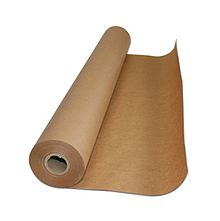

This article needs additional citations for verification. Please help improve this articlebyadding citations to reliable sources. Unsourced material may be challenged and removed.
Find sources: "Kraft paper" – news · newspapers · books · scholar · JSTOR (October 2011) (Learn how and when to remove this message) |

Kraft paperorkraft[1]ispaperorpaperboard (cardboard) produced from chemical pulp produced in the kraft process.
Sack kraft paper (or just sack paper) is a porous kraft paper with high elasticity and high tear resistance, designed for packaging products with high demands for strength and durability.[2]
Pulp produced by the kraft process is stronger than that made by other pulping processes; acidic sulfite processes degrade cellulose more, leading to weaker fibers, and mechanical pulping processes leave most of the lignin with the fibers, whereas kraft pulping removes most of the lignin present originally in the wood. Low lignin is important to the resulting strength of the paper, as the hydrophobic nature of lignin interferes with the formation of the hydrogen bonds between cellulose (and hemicellulose) in the fibers.[3]
Kraft pulp is darker than other wood pulps, but it can be bleached to make very white pulp. Fully bleached kraft pulp is used to make high quality paper where strength, whiteness, and resistance to yellowing are important.

Wood pulp for sack paper is made from softwood by the kraft process. The long fibers provide the paper its strength and wet strength chemicals are added to even further improve the strength. Both white and brown grades are made. Sack paper is then produced on a paper machine from the wood pulp. The paper is microcrepped to give porosity and elasticity. Microcrepping is done by drying with loose draws allowing it to shrink. This causes the paper to elongate 4% in the machine direction and 10% in the cross direction without breaking.[2] Machine direction elongation can be further improved by pressing between very elastic cylinders causing more microcrepping.[2] The paper may be coated with polyethylene (PE) to ensure an effective barrier against moisture, grease and bacteria, although recyclability is hindered. Zein coatings are also water resistant but allow better recyclability.[4]
A paper sack can be made of several layers of sack paper depending on the toughness needed.
Kraft paper is produced on paper machines with moderate machine speeds. The raw material is normally softwood pulp from the kraft process.
Maintaining a high effective sulfur ratio or sulfidity is important for the highest possible strength using the kraft process.
The kraft process can use a wider range of fiber sources than most other pulping processes. All types of wood, including very resinous types like southern pine,[5] and non-wood species like bamboo and kenaf can be used in the kraft process.

This industry-related article is a stub. You can help Wikipedia by expanding it. |
|
| |||||||
|---|---|---|---|---|---|---|---|
| |||||||
| History |
| ||||||
| Types |
| ||||||
| Materials |
| ||||||
| Specifications |
| ||||||
| Manufacture and process |
| ||||||
| Industry |
| ||||||
| Uses |
| ||||||
| |||||||